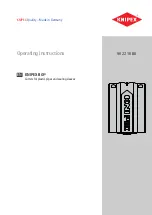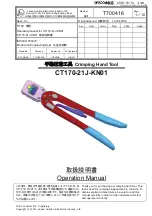
408-6757
Rev F
2
of 5
3.
DIE INSERTION AND REMOVAL
1. Pull out the latch pin and open the yoke. See Figure 1.
2. Advance the ram slightly to gain access to the moving die setscrew. Note that the stationary die is
held in place by a setscrew.
3. Before inserting the dies, refer to the instruction sheet packaged with the dies for detailed instructions:
insert or remove dies, as necessary, by following the procedures given in the instruction sheet.
4.
CRIMPING PROCEDURE
1. Strip the wires to the dimensions specified in the instructions packaged with the dies (see Figure 1).
2. Insert the terminal or splice in the stationary die according to the instruction sheet packaged with the
dies.
DANGER
Ensure latch pin is fully inserted before operating hand tool.
3. Pump the movable lever until the moving die grips the terminal or splice.
CAUTION
Do not deform the wire barrel of the terminal or splice.
4. Insert the stripped wire into the wire barrel of the terminal or splice.
5. Continue pumping the moveable lever. There may be a slight audible click, indicating that the pump
has shifted into the high-pressure stage. Continue pumping the moveable lever. When the dies have
bott
omed, there will be an audible “pop”. This indicates that the crimp is complete.
CAUTION
Potential damage to the tool may occur if the following Step 6 is not taken.
6.
Retract movable die by opening the movable handle to the full open position, turn the movable handle
(to actuate striker), DO NOT TURN THE MOVABLE HANDLE WHILE IN THE CLOSED POSITION
AS YOU WILL DAMAGE THE PLUNGER (PRESSURE RELEASE), compress handles to depress
plunger (pressure release). Movable die will now retract. See Figure 1.
7. Remove the latch pin, open the yoke, and remove the crimped terminal or splice.
NOTE
If the terminal or splice sticks in the die after crimping, apply a rocking action to remove it from the die.
8. Inspect the crimped terminal or splice according to the inspection procedure in the instruction sheet
packaged with the dies.
5.
MAINTENANCE AND INSPECTION
It is recommended that a maintenance and inspection program be performed periodically to ensure dependable
and uniform terminations. Though recommendations call for at least one inspection a month, frequency of
inspection depends on:
1. The care, amount of use, and handling of the hand tool.
2. The presence of abnormal amounts of dust and dirt.
3. The degree of operator skill.
4. Your own established standards.
The hand tool is inspected before being shipped; however, it is recommended that the tool be inspected
immediately upon arrival at your facility to ensure that the tool has not been damaged during shipment.
5.1.
Daily Maintenance
1. Hand tool should be immersed (levers partially closed) in a reliable commercial degreasing compound
to remove accumulated dirt, grease, and foreign matter. When degreasing compound is not available,
tool may be wiped clean with a soft, lint-free cloth. Do NOT use hard or abrasive objects that could
damage the tool.























